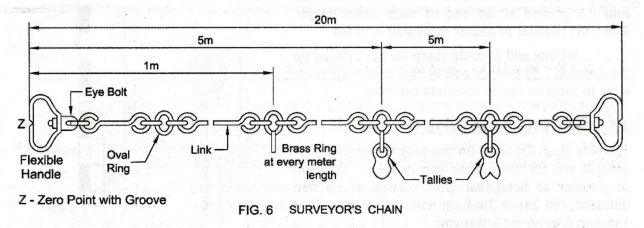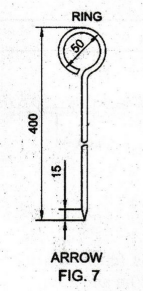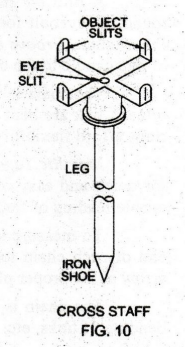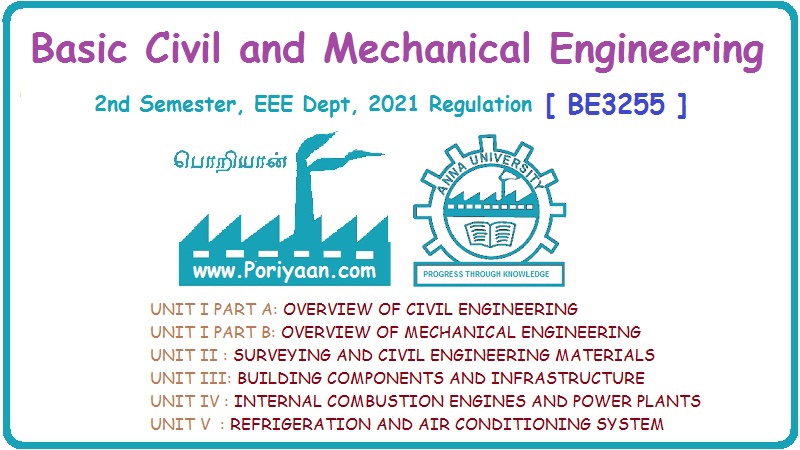Basic Civil & Mechanical Engineering: UNIT II: b. Chain surveying
Instruments used in Chain Surveying
Instruments for Measuring Horizontal Distance 1. Surveyor's Chain 2 . Steel Band 3. Tape 4. Arrows (Chain Pins) Instruments for Marking Stations on the Ground 5. Ranging Rods 6. Offset Rods: 7. Cross Staff 8. Plumb Bob 9. Pegs and Wooden Hammer 10. Field Book
CHAIN SURVEYING
Instruments
used in Chain Surveying
Instruments
for Measuring Horizontal Distance
1.
Surveyor's Chain 2 . Steel Band 3. Tape 4. Arrows (Chain Pins)
Instruments
for Marking Stations on the Ground
5.
Ranging Rods 6. Offset Rods: 7. Cross
Staff 8. Plumb Bob 9. Pegs and Wooden Hammer 10. Field Book
1. SURVEYOR'S CHAIN (Fig. 6)

Surveyor's
Chain is used for measuring Horizontal Distances in the field. Chains are
available in lengths of 5m, 10m, 20m and 30m.
A
Flexible Handle is provided at each end of the chain. It is easy to swivel the
handle round the eyebolt for dragging the chain on the ground. The outside of
the handle is the Zero Point with a Groove at the end of the chain. The length
of chain is the distance from the outside of one handle to the outside of the
other.
The
chain is formed of wire Links. Each meter length is divided into 5 links. The
ends of each link are bent into loops and connected together by means of
Oval-Shaped Rings. These rings afford flexibility to the chain.
Metallic
Tags called Tallies of different patterns are fixed for every 5 meters of the
chain for quick and easy reading of the distance. Brass Rings are provided at
every meter length to enable reading of fractions of a chain.
To
measure longer distances, the chain is used a number of times in succession. At
the end of each chain length, an Arrow is driven into the ground. To avoid
errors in driving the arrow at the proper place, a Groove is provided on the
outer face of each handle.
The
chain is easily read. But, it is liable to slight variations in its length due
to wear, bending of links, etc.
2. STEEL BAND or BAND CHAIN
It
consists of a steel ribbon of 20 or 30 m length, with a swivel handle at each
end. The graduations are etched as meters, decimeters, centimeters. **
Advantages: Measurements are more accurate than chains. Steel band is easier to
handle and light in weight. Length is not altered due to usage as compared to
the chain.
3. STEEL TAPE Steel
Tape
is used to make linear measurements where fractional lengths are to be measured
accurately. It is also used for measuring offset distances of different objects
from the chain line.
4. ARROWS (Fig. 7)
Arrow
is also known as Chaining Pin. It is driven into the ground at the end of each
chain length. Thus, the number of chains measured is noted.
Its
one end is made sharp for easy fixing on the ground. The other end is bent into
a Circular Ring to form an eye to facilitate carrying.

5. RANGING RODS (Fig. 8)
Ranging
Rods are used for marking the positions of státions and for ranging the survey
lines. They are of circular or octagonal cross-section of 30 mm diameter and 2m
or 3m long with a Cast Iron Shoe 150 mm long at the lower end.

They
are painted alternately red and white for 200 mm sections to make them visible
at a distance. A Flag is tied at the top to make the station visible from a
considerable distance.
6. OFFSET RODS (Fig. 9)

Offset
Rod is similar to ranging rod. It is used to measure the nearby rough offsets.
A Hook is provided to assist pulling or pushing the chain through obstructions
like bushes, etc.
7. CROSS STAFF (Fig. 10)

It
consists of four Arms such that a pair of arms is at right angles to the other.
Each pair consists of Eye Slit and Object Slit to give a straight line of
sight. It is used for setting out right angles from a point on the chain line
and dropping a na dropping & perpendicular from a given object to the chain
line.
8. PLUMB BOB (Fig. 11)

It
consists of a conical weight suspended by a Thread. When chaining is performed
over sloping ground, a Plumb Bob is used to transfer the points of the ends of
the chain to the ground. It is also used for centering of Theodolite Compass at
a station and to check the verticality of a ranging rod.
9. PEGS AND WOODEN HAMMER
Stations
or terminal points of a line are marked on the ground by driving Wooden Pegs.
One end of the peg is tapered. Each peg is driven by Wooden Hammer. Field Book
is used to enter the details of measurement.
Basic Civil & Mechanical Engineering: UNIT II: b. Chain surveying : Tag: : - Instruments used in Chain Surveying
Related Topics
Related Subjects
Basic Civil and Mechanical Engineering
BE3255 2nd Semester 2021 Regulation | 2nd Semester EEE Dept 2021 Regulation
